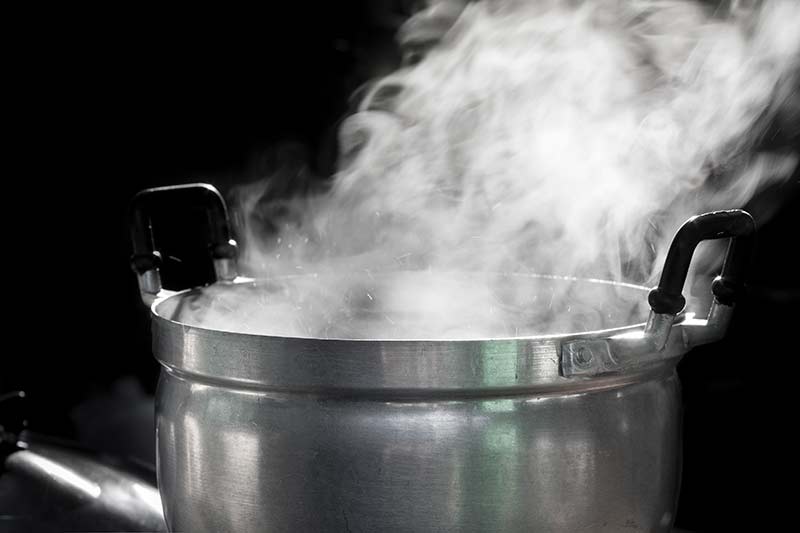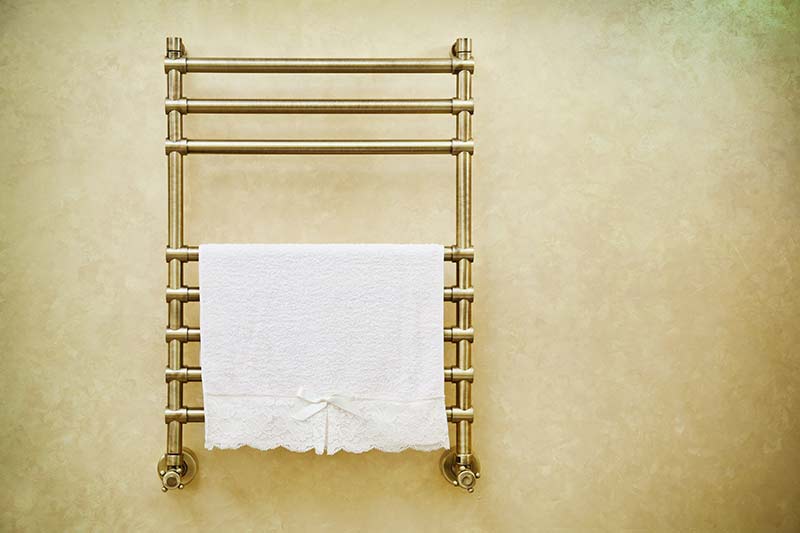Do you want to increase the moisture level in the air in your home without buying a humidifier? This article will explain 10 ways that you can inexpensively humidify a room. Check it out!
Tips to humidify a room without a humidifier:
- Boil water
- Get houseplants
- Cook on the stove
- Keep the bathroom door open when showering
- Fill bowls with water
- Dry your clothes inside
- Let the bathtub water cool before draining it
- Use stove steamers
- Wet sponges
- Put damp towels on the radiators
Humidifiers are expensive. But you can use some creative methods to humidify your home just as well and at half the price.
Do you want to know how you can get some humidity into your air again?
Then make sure you take a look at the full hints and tips below.
How to Humidify a Room… Without a Humidifier
Overly dry air in the winter is very uncomfortable. It can cause a whole host of problems such as:
- Dry skin
- Itchy skin
- Sinusitis
- Respiratory problems
- Sore throats
- Eye irritation
- Nosebleeds
But, the thought of paying to put humidity back into the air could seem a little ludicrous. This is especially so when we spend money taking the humidity out of our homes in the summer.
Wouldn’t it be great if we could bottle up the humidity we don’t want in the summer and release it in stages in the winter? But while we wait for that breakthrough in technology we have to find a way to get through this winter without declaring bankruptcy. After all, humidifiers can be expensive. Some models can cost you hundreds of dollars!
So, what can you do to increase the humidity in your home with the things you already have? Take a look at the following list to find out.
1. Boil Water
One of the quickest ways for you to get humidity into a room is to boil water. You can fill the kettle with water and then leave the lid off once the water has boiled. That way the water vapor will enter the atmosphere.
A slower, but more effective way would be to boil water in a large soup pot. This way, you can leave the lid off while the water is boiling to humidify your kitchen. Once the water has boiled, put the lid back on the soup pot. You can then transfer the pot to the room that you want to humidify and remove the lid.
Are you ready to find out some more about this method? Then take a look at the pros and cons below:
| Pros | Cons |
|---|---|
| – This method is quick. – It’s easy to transport the water vapor to different places in the house. | – This could be an expensive long-term solution. That’s because of the cost that comes with constantly using a kettle or keeping the stove on high. |

2. Get Houseplants
Now, this may just be one of the prettiest methods you can use to humidify a room. Houseplants sweat and excrete water vapor throughout the day. This makes them a great source of humidity. You can also maximize the humidity in your home by:
- Watering your plants every day. (Just be careful not to drown them!)
- Placing a plant in every room in the house. The more plants you have, the higher the humidity!
As with every method, it comes with some pros and cons. Take a look at them below:
| Pros | Cons |
|---|---|
| – After the initial cost, this becomes quite an economic way to add. humidity to a room. | – It will take quite a few plants to humidify a larger room. – It may be difficult to keep plants in some rooms that don’t get much sunlight. |
3. Cook on the Stove
I get it. There’s nothing better than coming home at the end of a long day and shoving something tasty in the oven for dinner. It’s quick, easy, and delicious. But cooking in the oven doesn’t generate half as much humidity as cooking on a stovetop.
Cooking on the stovetop generates water vapor that fills the air. If you have an extractor fan hood, make sure you keep it switched off while you’re cooking to maximize the humidity.
Let’s delve a little further into this method with some pros and cons:
| Pros | Cons |
|---|---|
| – You can humidify the kitchen every time you cook. You will not be wasting any extra gas or electricity on this method. – This method is ideal for humidifying the kitchen. | – It will be tricky for you to use this method to humidify rooms in the house other than the kitchen. At best, the humidity might travel into one of the rooms closest to the kitchen. – It could be hard for you to keep the room humid unless you are constantly cooking on the stovetop. |
4. Keep the Bathroom Door Open When Showering
Most homes have an extractor fan in the bathroom that helps to get rid of the humidity after you shower. Make sure that it is turned off if you want to add humidity to your home. Showering with the door open will help the humidity to travel to other rooms in the house.
Here’s a rundown on some of the pros and cons of this method:
| Pros | Cons |
|---|---|
| – You can humidify the bathroom every time you shower. You will not be wasting any extra gas or electricity with this method. – This method is ideal for humidifying the bathroom. | – It will be tricky for you to use this method to humidify rooms in the house other than the bathroom. At best, the humidity might travel into one of the rooms closest to the bathroom. |

5. Fill Bowls With Water
Strategically placed bowls filled with water can also humidify a room. You can place bowls in the following places in the home:
- On the radiators
- On the window ledges
The heat from the radiators will make the water in the bowls slowly evaporate. This will add humidity to the air. You can also put bowls of water on your window ledges. This way, the heat from the sun against the glass will slowly evaporate the water having the same effect. You might even find it more effective to place glass vases of water on window ledges.
Here’s everything you need to know about this method:
| Pros | Cons |
|---|---|
| – This method is inexpensive as natural sunlight will evaporate the water in the bowls. If you are using radiators to heat the water, keep them on their normal heating cycle. | – Placing bowls of water on radiators may be a bit precarious if you have small children in the home. |
6. Dry Your Clothes Inside
Drying your clothes inside is another creative way of adding humidity to a room. It is also a nice way of getting the comforting scent of fabric softener drifting around the house.
When you dry your clothes inside, the water that was held in them will evaporate into the room. This makes damp clothes a great solution for dry air.
Here’s a summary of everything you should know about this method:
| Pros | Cons |
|---|---|
| – Drying your clothes inside will help you to save on the cost of running a dryer. – You can take your damp clothes from room to room on a drying rack. This will help you to humidify more than one room. | – Drying your clothes inside without the radiator could be difficult during the winter. |
7. Let the Bathtub Water Cool Before Draining It
There’s nothing like soaking in a hot bath on a cold winter’s evening. Hot baths also add humidity to the room. Talk about killing two birds with one stone!
You can make the most of the steam from a bath by doing the following:
- Turn off the extractor fan in the bathroom. Allow the humidity to fill the air.
- Open the bathroom door. Once you have finished bathing, open the door to let the humidity escape into other rooms.
- Let the water cool before draining it. The water will continue to evaporate slowly even if it’s only warm. Let it cool completely before you pull the bath plug.
Here are the pros and cons of this method:
| Pros | Cons |
|---|---|
| – You can humidify the bathroom every time you have a bath. You will not be wasting any extra gas or electricity on this method. – This method is ideal for humidifying the bathroom. | – It will be tricky for you to use this method to humidify rooms in the house other than the bathroom. At best, the humidity will travel into the room closest to the bathroom. |
8. Use Stove Steamers
Do you have a wood-burning stove at home? Then why not take advantage of it to add humidity to the air using a stove steamer. You can fill the stove steamer with water. The water will boil and then evaporate releasing moisture into the air.
Are you ready to find out some more about this method? Then take a look at the pros and cons below:
| ProsCons- You can humidify the living room every time you want to burn the log fire. | – Stove steamers are usually small. So, it will be difficult for you to use this method to humidify rooms other than the one that the stove fire is in. |
|---|
9. Wet Sponges
Wet sponges. This may sound like the strangest suggestion so far, but it may also be one of the easiest!
A wet sponge is a super simple way of adding humidity to a room. Here’s how to do it:
- Wet a sponge in water and then squeeze out enough water for it to stop dripping.
- Keep the sponge on top of a plastic bag.
- Take the sponge to the room you want to humidify. As time passes the sponge will dry out and evaporate the water into the atmosphere.
As with every method, this one comes with its pros and cons. Take a look at them below:
| Pros | Cons |
|---|---|
| – It’s easy to use this method in any room in the house. – This method is inexpensive. | – You may need to wet quite a few sponges if you want to humidify a big room in the house. |
10. Put Damp Towels on the Radiators
Putting damp towels on the radiators and allowing them to dry is also a good way of humidifying a room. The water locked in the towel fibers slowly evaporates as the towel heats up. This releases moisture into the atmosphere.
Let’s dig a little deeper into this method with some pros and cons:
| Pros | Cons |
|---|---|
| – It’s easy to use this method in any room that has a radiator. This way, you can humidify just about every room in the house. | – Covering your radiators with towels could stop them from heating your house well. This may cause an increase in your heating bills. |

How Much Does a Humidifier Cost?
Before purchasing a humidifier, you’re no doubt keen to find out just how much one will cost you. Humidifiers range massively in price. They start at under $10 and spiral into the hundreds. So, how can you know what you are getting for your money? Take a look at the information below to find out.
Humidifier Prices by Gallon Capacity
| Gallon Capacity of the Humidifier | Normal Price of a Humidifier |
| Mini Humidifiers 200 ml or Smaller | Less than $10 |
| 1 to 2 Gallon Capacity | Starting at $20 |
| 3 to 5 Gallon Capacity | Starting at $40 |
Humidifier Prices by Type
| Type of Humidifier | Normal Price of a Humidifier |
| Evaporative Humidifiers | Starting at $50 |
| Ultrasonic Humidifiers | Between $40 and $250 depending on the gallon capacity |
| Vaporizer Humidifiers | Starting at $20 |
Humidifier Prices by Square Foot Coverage Area
| Humidity Coverage Area in Square Foot | Normal Price of a Humidifier |
| Small Coverage Area (up to 300 sq ft) | Starting at $20 |
| Medium Coverage Area (up to 600 sq ft) | Starting at $45 |
| Large Coverage Area (up to 1000 sq ft) | Starting at $100 |

Conclusion
Overly dry air can be very uncomfortable and trigger existing health problems. Using a humidifier is a great way of adding moisture to the air but humidifiers are pricey. I’m sure this article has shown you some inexpensive ways to humidify the air in your home that you can try.
If this article has helped you, then why not check out some of our other articles and free guides? You could even sign up to our email list!
Have a great day!
-Craig







